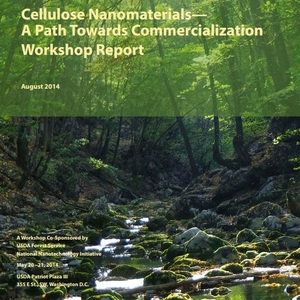Report charts path to development of cellulosic nanomaterials




USDA
November 25, 2014
BY USDA
The U.S. Forest Service has released a report that details the pathway to commercializing affordable, renewable, and biodegradable cellulose nanomaterials from trees. Cellulosic nanomaterials are tiny, naturally occurring structural building blocks and hold great promise for many new and improved commercial products. Commercializing these materials also has the potential to create hundreds of thousands of American jobs while helping to restore our nation's forests.
"This report is yet another important step toward commercializing a material that can aid in restoring our nations' forests, provide jobs, and improve products that make the lives of Americans better every day," said U.S. Forest Service Chief Tom Tidwell. "The Forest Service plans to generate greater public and market awareness of the benefits and uses for these naturally-occurring nanomaterials."
The report, titled " Cellulose Nanomaterials – A Path towards Commercialization," is a result of a workshop held earlier this year that brought together a wide range of experts from industry, academia, and government to ensure that commercialization efforts are driven by market and user materials needs.
Cellulose nanomaterials have the potential to add value to an array of new and improved products across a range of industries, including electronics, construction, food, energy, health care, automotive, aerospace, and defense, according to Ted Wegner, assistant director at the U.S. Forest Service Forest Products Laboratory in Madison, Wisconsin.
Advertisement
Advertisement
"These environmentally friendly materials are extremely attractive because they have a unique combination of high strength, high stiffness, and light weight at what looks to be affordable prices," Wegner explained. "Creating market pull for cellulose nanomaterials is critical to its commercialization.
The success of this commercialization effort is important to the U.S. Forest Service for another key reason: creating forests that are more resilient to disturbances through restorative actions. Removing excess biomass from overgrown forests and making it into higher value products like nanocellulose, is a win for the environment and for the economy.
"Finding high-value, high-volume uses for low-value materials is the key to successful forest restoration," said Michael T. Rains, director of the Northern Research Station and Forest Products Laboratory. "With about 400 million acres of America's forests in need of some type of restorative action, finding markets for wood-based nanocellulose could have a huge impact on the economic viability of that work."
Advertisement
Advertisement
The U.S. Forest Service, in collaboration with the U.S. National Nanotechnology Initiative, organized the workshop. Participants included over 130 stakeholders from large volume industrial users, specialty users, Federal Government agencies, academia, non-government organizations, cellulose nanomaterials manufactures and industry consultants. The workshop generated market-driven input in three areas: Opportunities for Commercialization, Barriers to Commercialization, and Research and Development Roles and Priorities. Issues identified by participants included the need for more data on materials properties, performance, and environmental, health, and safety implications and the need for a more aggressive U.S. response to opportunities for advancing and developing cellulose nanomaterial.
"The workshop was a great opportunity to get research ideas directly from the people who want to use the material," says World Nieh, the U.S. Forest Service's national program lead for forest products. "Getting the market perspective and finding out what barriers they have encountered is invaluable guidance for moving research in a direction that will bring cellulose nanomaterials into the marketplace for commercial use."
The mission of the U.S. Forest Service, part U.S. Department of Agriculture, is to sustain the health, diversity and productivity of the nation's forests and grasslands to meet the needs of present and future generations. The agency manages 193 million acres of public land, provides assistance to state and private landowners, and maintains the largest forestry research organization in the world. Public lands the Forest Service manages contribute more than $13 billion to the economy each year through visitor spending alone. Those same lands provide 20 percent of the nation's clean water supply, a value estimated at $7.2 billion per year. The agency has either a direct or indirect role in stewardship of about 80 percent of the 850 million forested acres within the U.S., of which 100 million acres are urban forests where most Americans live.
Related Stories
The U.S. Department of Energy Bioenergy Technologies Office (BETO) announced up to $23 million in funding to support research and development (R&D) of domestic chemicals and fuels from biomass and waste resources.
The U.S. DOE has announced its intent to issue funding to support high-impact research and development (R&D) projects in two priority areas: sustainable propane and renewable chemicals and algal system cultivation and preprocessing.
Sens. Sherrod Brown, D-Ohio, and Pete Ricketts, R-Neb., in August introduced the Renewable Chemicals Act, a bill that aims to create a tax credit to support the production of biobased chemicals.
The Chemical Catalysis for Bioenergy Consortium, a consortium of the U.S. DOE’s Bioenergy Technologies Office, has launched an effort that aims to gather community input on the development of new biomass processing facilities.
USDA on March 8 celebrated the second annual National Biobased Products Day, a celebration to raise public awareness of biobased products, their benefits and their contributions to the U.S. economy and rural communities.
Upcoming Events










